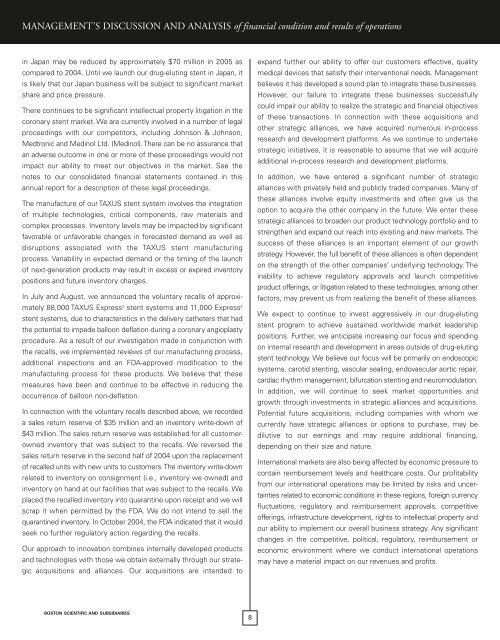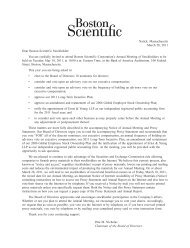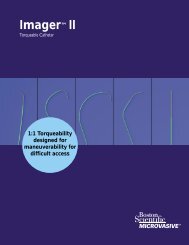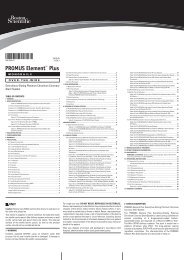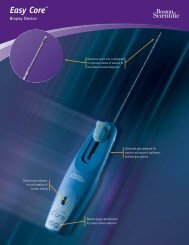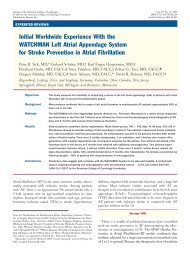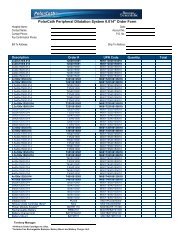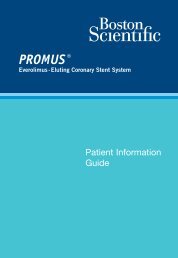CONSOLIDATED FINANCIAL STATEMENTS - Boston Scientific
CONSOLIDATED FINANCIAL STATEMENTS - Boston Scientific
CONSOLIDATED FINANCIAL STATEMENTS - Boston Scientific
You also want an ePaper? Increase the reach of your titles
YUMPU automatically turns print PDFs into web optimized ePapers that Google loves.
MANAGEMENT’S DISCUSSION AND ANALYSIS of financial condition and results of operations<br />
in Japan may be reduced by approximately $70 million in 2005 as<br />
compared to 2004. Until we launch our drug-eluting stent in Japan, it<br />
is likely that our Japan business will be subject to significant market<br />
share and price pressure.<br />
There continues to be significant intellectual property litigation in the<br />
coronary stent market. We are currently involved in a number of legal<br />
proceedings with our competitors, including Johnson & Johnson,<br />
Medtronic and Medinol Ltd. (Medinol). There can be no assurance that<br />
an adverse outcome in one or more of these proceedings would not<br />
impact our ability to meet our objectives in the market. See the<br />
notes to our consolidated financial statements contained in this<br />
annual report for a description of these legal proceedings.<br />
The manufacture of our TAXUS stent system involves the integration<br />
of multiple technologies, critical components, raw materials and<br />
complex processes. Inventory levels may be impacted by significant<br />
favorable or unfavorable changes in forecasted demand as well as<br />
disruptions associated with the TAXUS stent manufacturing<br />
process. Variability in expected demand or the timing of the launch<br />
of next-generation products may result in excess or expired inventory<br />
positions and future inventory charges.<br />
In July and August, we announced the voluntary recalls of approximately<br />
88,000 TAXUS Express2 stent systems and 11,000 Express2 stent systems, due to characteristics in the delivery catheters that had<br />
the potential to impede balloon deflation during a coronary angioplasty<br />
procedure. As a result of our investigation made in conjunction with<br />
the recalls, we implemented reviews of our manufacturing process,<br />
additional inspections and an FDA-approved modification to the<br />
manufacturing process for these products. We believe that these<br />
measures have been and continue to be effective in reducing the<br />
occurrence of balloon non-deflation.<br />
In connection with the voluntary recalls described above, we recorded<br />
a sales return reserve of $35 million and an inventory write-down of<br />
$43 million. The sales return reserve was established for all customer-<br />
owned inventory that was subject to the recalls. We reversed the<br />
sales return reserve in the second half of 2004 upon the replacement<br />
of recalled units with new units to customers. The inventory write-down<br />
related to inventory on consignment (i.e., inventory we owned) and<br />
inventory on hand at our facilities that was subject to the recalls. We<br />
placed the recalled inventory into quarantine upon receipt and we will<br />
scrap it when permitted by the FDA. We do not intend to sell the<br />
quarantined inventory. In October 2004, the FDA indicated that it would<br />
seek no further regulatory action regarding the recalls.<br />
Our approach to innovation combines internally developed products<br />
and technologies with those we obtain externally through our strategic<br />
acquisitions and alliances. Our acquisitions are intended to<br />
BOSTON SCIENTIFIC AND SUBSIDIARIES<br />
8<br />
expand further our ability to offer our customers effective, quality<br />
medical devices that satisfy their interventional needs. Management<br />
believes it has developed a sound plan to integrate these businesses.<br />
However, our failure to integrate these businesses successfully<br />
could impair our ability to realize the strategic and financial objectives<br />
of these transactions. In connection with these acquisitions and<br />
other strategic alliances, we have acquired numerous in-process<br />
research and development platforms. As we continue to undertake<br />
strategic initiatives, it is reasonable to assume that we will acquire<br />
additional in-process research and development platforms.<br />
In addition, we have entered a significant number of strategic<br />
alliances with privately held and publicly traded companies. Many of<br />
these alliances involve equity investments and often give us the<br />
option to acquire the other company in the future. We enter these<br />
strategic alliances to broaden our product technology portfolio and to<br />
strengthen and expand our reach into existing and new markets. The<br />
success of these alliances is an important element of our growth<br />
strategy. However, the full benefit of these alliances is often dependent<br />
on the strength of the other companies’ underlying technology. The<br />
inability to achieve regulatory approvals and launch competitive<br />
product offerings, or litigation related to these technologies, among other<br />
factors, may prevent us from realizing the benefit of these alliances.<br />
We expect to continue to invest aggressively in our drug-eluting<br />
stent program to achieve sustained worldwide market leadership<br />
positions. Further, we anticipate increasing our focus and spending<br />
on internal research and development in areas outside of drug-eluting<br />
stent technology. We believe our focus will be primarily on endoscopic<br />
systems, carotid stenting, vascular sealing, endovascular aortic repair,<br />
cardiac rhythm management, bifurcation stenting and neuromodulation.<br />
In addition, we will continue to seek market opportunities and<br />
growth through investments in strategic alliances and acquisitions.<br />
Potential future acquisitions, including companies with whom we<br />
currently have strategic alliances or options to purchase, may be<br />
dilutive to our earnings and may require additional financing,<br />
depending on their size and nature.<br />
International markets are also being affected by economic pressure to<br />
contain reimbursement levels and healthcare costs. Our profitability<br />
from our international operations may be limited by risks and uncertainties<br />
related to economic conditions in these regions, foreign currency<br />
fluctuations, regulatory and reimbursement approvals, competitive<br />
offerings, infrastructure development, rights to intellectual property and<br />
our ability to implement our overall business strategy. Any significant<br />
changes in the competitive, political, regulatory, reimbursement or<br />
economic environment where we conduct international operations<br />
may have a material impact on our revenues and profits.


